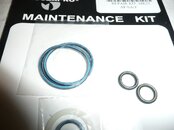Zung
Contributor
Thanks for the explanations Bro.
For the record, all the o-rings in that reg are stock SP, 2-010 EPDM 85 for the stem, red stripe (ring), and 2-022 EPDM 70 (x 2) for the crown, blue stripe (ring), plus a 2-011 EPDM 85 for the seat, yellow stripe (ring), but this last one doesn't move.
Next time I do the mattmagic, I'll leave the area where the stem o-ring rides rough. It's about 5 mm from the tip and about 10 mm long.
For the record, all the o-rings in that reg are stock SP, 2-010 EPDM 85 for the stem, red stripe (ring), and 2-022 EPDM 70 (x 2) for the crown, blue stripe (ring), plus a 2-011 EPDM 85 for the seat, yellow stripe (ring), but this last one doesn't move.
Next time I do the mattmagic, I'll leave the area where the stem o-ring rides rough. It's about 5 mm from the tip and about 10 mm long.
Last edited:




